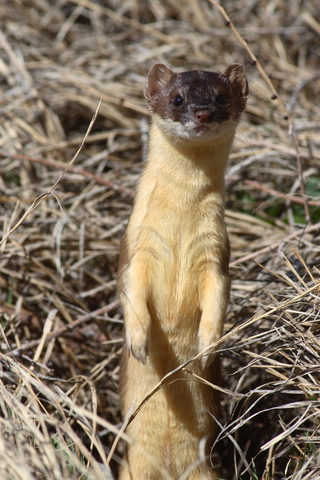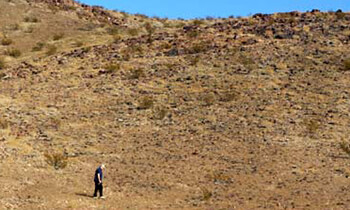The Long-Tailed Weasel
(Mustela frenata)
by Jay Sharp

The long-tailed weasel – like its taxonomic brethren, the least weasel and the short-tailed weasel (also known as an ermine or a stoat) – may seem as endearing as a curious, lively kitten, but in fact, ounce for ounce, it ranks as one of nature's most relentless and ferocious predators. Indeed, it has been called "nature's psychopath."
Distinctive Features
A small animal that favors the night, the weasel typically follows a solitary secretive lifestyle, although it sometimes makes unanticipated appearances—fearlessness and inquisitive.
- Appearance: Long, supple and slender bodied, it has a small head, long neck, long domestic catlike tail and short legs. "At every bound," said the New Mexico State University Cooperative Extension service, "the long body loops upward, reminding one of an inch-worm."
- Adult Size and Weight: An adult male typically measures 18 to 20 inches in overall length, including its 7- to 8-inch long tail, and it weighs 10 to 18 ounces. The adult female is usually 5 to 10 percent smaller.
- Coat and Color: The long-tailed weasel has an almost silky brownish-colored fur on its back, sides and tail, and it has a buff-colored fur on its undersides. It has a distinctive black tip on its tail. The subspecies found across much of the southwestern United States may have a dark mask on its face, ears and forehead with white patches between its eyes and on its cheeks, chin and throat. In northern parts of its range, the long-tailed weasel may turn white in the winter although it retains the black tip on its tail. In his article "Weasels," Gary Rising described the weasel as "remarkably handsome in that soft, pettable ermine coat..."
- Head and Face: The animal has a relatively broad and slightly flattened head with a pointed muzzle, long sharp canine teeth, short rounded ears, small beady eyes and large whiskers.
- Scent Glands: The weasel has strong anal scent glands that produce a strong, foul musky odor, which it releases by dragging its body over a firm surface, hoping, presumably, to attract a mate, mark territory or discourage a predator.
- Senses: The animal has well-developed senses of sight, hearing and smell, which enhance its skills as a predator.
- Communication: Voluble, it produces sounds ranging from excited shrieks and squeals to soothing purrs and trills.
Distribution and Habitat
The long-tailed weasel, with several dozen subspecies, occupies a wide range, which extends from southwestern Canada southward across the United States (excepting parts of the Southwest) and southward into Mexico and Central America and well into the South American continent. Indeed, in the Western Hemisphere, it has the widest range of any of the Mustelidae family, which includes not only the least and short-tailed weasels, but also animals such as badgers, skunks and ferrets.
In its home territories in the arid southwestern United States, the long-tailed weasel occupies a diversity of habitats, provided water and prey are available. On the desert floor, for instance, it may take up residence, sometimes in several dens, near streams lined by open grasslands, shrubs or wooded areas. It may occupy farmlands with livestock ponds or irrigation canals.
Diet
The weasel, with a high metabolism rate, must consume prey equivalent to as much as 30 to 40 percent of its body weight every day. It caches surplus food to offset shortfalls. Its diet includes, according to The Mammals of Texas, "ground squirrels, pocket gophers, wood rats, cotton rats, small cottontails, and so forth; insects make up a small percentage of the total diet. Birds are rarely taken when other foods are available."
Behavior and Life Cycle
The male long-tailed weasel stakes out a home range of 30 to 40 acres, said the NMSU service, making a home – or several homes – in an abandoned rodent burrow, rocky overhang or rotting log. "Population densities," said the service, "fluctuate considerably with year-to-year changes in small mammal abundance, and densities differ greatly among habitats."
Given its high rate of metabolism and expenditure of energy, the weasel hunts to live and lives to hunt. Active throughout the year, it follows favored hunting routes repeatedly across its range, though seldom retracing one on consecutive days. Capitalizing on its supple and slender body, it invades narrow dens, climbs trees and shrubs, swims swift streams, and even tunnels beneath snow in its quest for prey. It may climb 20 feet up a tree to capture a squirrel.
It attacks its quarry, sometimes one several times larger than itself, with unbridled ferocity. It kills small prey by driving its sharp incisors into the head. It ambushes larger prey, clinching to the back and biting into the neck, inflicting a lethal wound. Although it is much more likely to attack rodents and other pests, it has been known to invade a poultry coop and, in a killing frenzy, slaughter every chicken within the enclosure.
In early to midsummer, the long-tailed weasel foregoes its solitary lifestyle long enough to mate. During the mating period, the male may couple with several different females. A pregnant female's fertilized eggs will not be implanted on her uterine wall until early spring—the event that triggers embryonic development. Effectively, she delays the birth until the most favorable time of year for delivery.
Meanwhile, she may make her den in the burrow of one of her prey, lining the walls with the fur of the victim and with straw from nearby grasses. Typically, her den will extend several feet in length and have two openings a couple of feet apart.
In mid- to late spring, the female delivers three to eight blind, helpless and finely haired kits, each weighing roughly a tenth of an ounce. She nurses her young for several weeks, then begins weaning them and feeding them solid food. They grow rapidly, increasing their weight seven or eight fold within those first few weeks. They open their eyes and become increasingly active, then begin emerging from their nest. Within six or seven weeks, they begin accompanying their mother on hunts, learning their trade. By fall, they have become fully grown, and they begin independent lives. A female will reach sexual maturity within about 3 months, and a male, within about 12 months. With luck, a long-tailed weasel may live for several years in the wild.
Life's Hazards
The long-tailed weasel may fall to predatory birds such as hawks and owls; mammals such as foxes, bobcats and house cats; and snakes such as king snakes and gopher snakes. It may fool its predators by using its black tail tip to mimic its head, creating confusion and an escape opportunity.
Although the weasel's range and habitat have been profoundly altered by development and agriculture in many areas, the animal has proven supremely adaptable. In fact, it may prosper in human presence. "The species," said the International Union for Conservation of Nature and Natural Resources, "is listed as Least Concern as the species has a wide distribution range and is relatively common across its range."
Interesting Facts
- A hungry long-tailed weasel has no conscience. It may kill and eat its own siblings or offspring if no other food is available.
- In the colder parts of its range, the weasel may use much of its food just to maintain its body heat. It lies in a tight circle to stay warm.
- If cornered, a weasel may turn wildly vicious and aggressive, even attacking a human. In Life-histories of Northern Animals: Flesh-eaters, author Ernest Thompson Seton reported that a long-tailed weasel attacked a companion during a September wolf hunt in North Dakota. The weasel "ran up his legs a number of times, aiming at his throat," said Seton. "He had clutched it and cast it off again and again, but it had persisted, and it might have done him serious injury but for the prompt assistance of [a] bull terrier."
- Unfortunately for weasels, the animal has been identified with politicians, who try to "weasel out" of certain situations and "weasel word" the content of their public statements – all for political gain.
References
New Mexico State University, Cooperative Extension Service, College of Agricultural, Consumer and Environmental Sciences.
David J. Schmidly, The Mammals of Texas, University of Texas Press, 2004.
Casey Dreis, "Long-Tailed Weasel (Mustela frenata)," Northern State University, 1997.
Union for Conservation of Nature and Natural Resources.
Ernest Thompson Seton, Life-histories of Northern Animals: Flesh-eaters, Nabu Press (July 12, 2011).
You might also like:
Share this page on Facebook:
The Desert Environment
The North American Deserts
Desert Geological Terms








